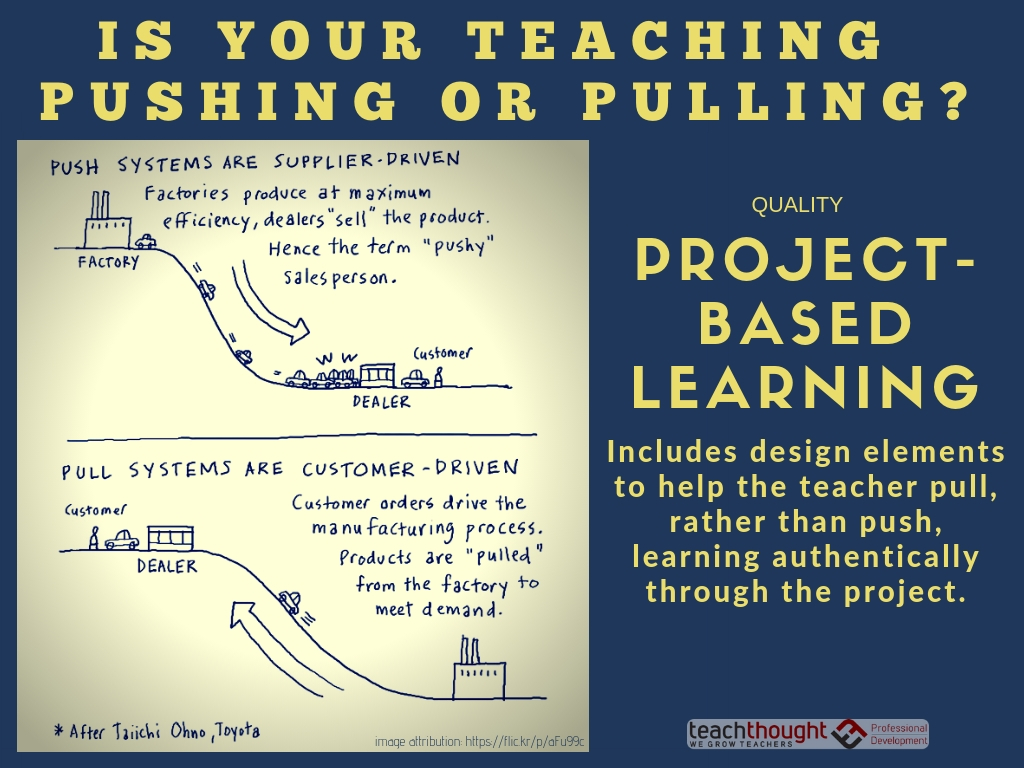
Are You Pushing Or Pulling Students In Your Classroom?
contributed by Drew Perkins
At the risk of characterizing teaching and learning in a factory context let’s face it, classrooms are a kind of marketplace system with an exchange of ideas and thinking incentivized by a variety of factors.
With this in mind, it can be helpful to think about the design and architecture of learning in a push vs. pull kind of way. When I say helpful, I mean this in the way that can help us empower students to think and learn about things more deeply while developing a set of processing skills that are transferable to other contexts and situations.
Deconstructing the push vs. pull graphic shown above, how many classroom teachers feel like a ‘pushy’ salesperson desperate to convince students that what they’re selling is worth buying. Some of those techniques include dangling grades and using points as an incentive in learning, trying to convince students they’ll need this in the future, or admonishing them for not paying attention because this will be on the test.
None of these tend to resonate with students and most often feel less than genuine for teachers. Positioning learning in terms of compliance will always be an uphill battle where even the best and most passionate teachers will struggle.
Sure there will be some students who will comply but how many won’t? And what do we do about them? Some more authoritarian educators (and non-educators) might take this opportunity to blast current culture and say kids should do what they’re told and sometimes that means doing something they don’t like.
I agree with this sentiment in some ways; I certainly require my own daughters to comply on certain things, but if that’s our go-to it’s not only going to be tough-sledding for all parties involved, it’s also a potential missed opportunity to build capacity in the learner in a way that might actually better prepare them for the modern world.
What Do Students Need To Know And Learn?
Rethinking the dynamics of teaching and learning to pull thinking from students can empower students as they learn how to identify what they need to learn and better understand to answer a challenge or question. In project-based learning, this dynamic takes place when a teacher initiates a project with a quality Driving Question and facilitates in a way that helps students identify what they need to understand and remember and as their Need to Know and Learn list.
Some of my favorite moments as a leader of professional development and coaching are seeing that ‘a-ha’ light bulb turn on for teachers as they realize the leverage that this process allows for as students learn how to uncover content. No longer does the teacher need to be solely responsible for ‘covering’ content, a practice that often feels like climbing the down escalator.

Using inquiry In Project-Based Learning
To be clear, this pull dynamic can surface outside of project-based learning, it’s the inquiry process that we’re focusing on here.
But why is this so important? The simplest answer is that it helps us change the culture and climate of our classrooms and schools away from one where adults and their learners are often inherently in conflict (adult: I want you to learn and do this — student: I don’t want to and you can’t make me). More importantly perhaps, is the building of a habit of mind where we’re helping these future adults to make better decisions, some of which can impact their entire lives.
Consider the 2008 housing crisis. How many people would have been able to avoid the disastrous effects of this market crash had they gone through the process of identifying and learning things they should know and understand before buying a house they couldn’t actually afford? If it’s a project-based world and buying a house is a project with a Driving Question of sorts like, “How can I/we create a plan to buy a house that meets my needs and budget?“
One would need to know and understand things like how a mortgage works, what happens if you can’t pay your mortgage, how and why housing prices fluctuate, how to avoid foreclosure, how banks profit from mortgages, etc. Heck, they might even learn these types of things from students doing authentic work like this (Good Explanation of the Subprime Mortgage Crisis) video that strikes me as likely created by students.
One criticism of constructivist teaching like this is that students need to have content and ‘stuff’ to think about. Or put another way, they ‘can’t think about anything.’ That’s absolutely correct but the false choice that most proponents argue is that we either ask students to learn and gain knowledge or we ask them to engage in inquiry in a kind of ‘free-range chicken’ type of setting. The former is a more traditional approach and yields a low-ceiling of results, the latter is a train wreck. Instead, let’s ask students to engage in both. Let’s pose interesting and meaningful (to them, not just us) questions and challenges that help us facilitate their thinking and learning to the content pieces and questions that are important to us.
When we engage in teaching and learning using a ‘pull’ dynamic we’re effectively helping students process the types of complex problems and ideas in ways they are likely to need to be able to do. This doesn’t mean content learning or knowledge isn’t important, far from it. But just knowing things won’t be good enough for the future. Being able to analyze, synthesize, evaluate…think critically and ask beautiful questions with and about that knowledge is what we need to focus on.
‘Push’ teaching at students is a low-yield way to build those abilities let alone produce great test results. Prepare your students for the modern world by asking beautiful questions of them that help pull profound thinking and deeper learning.
